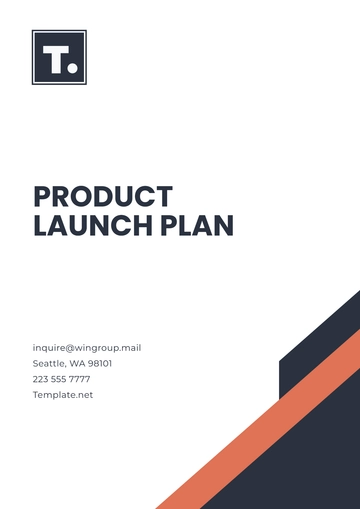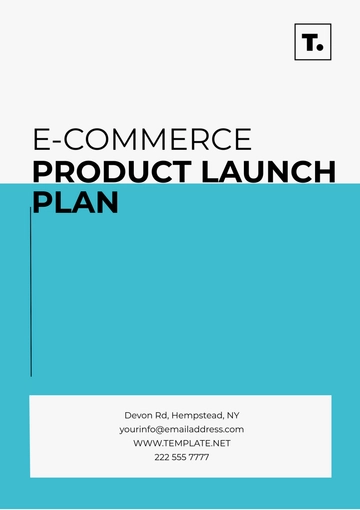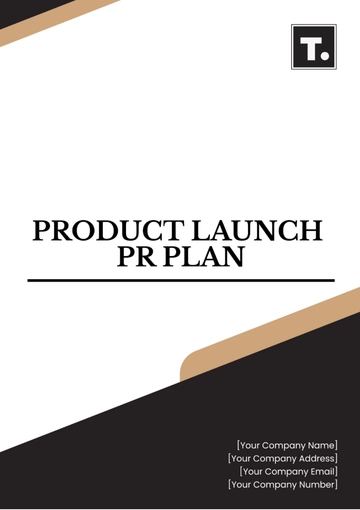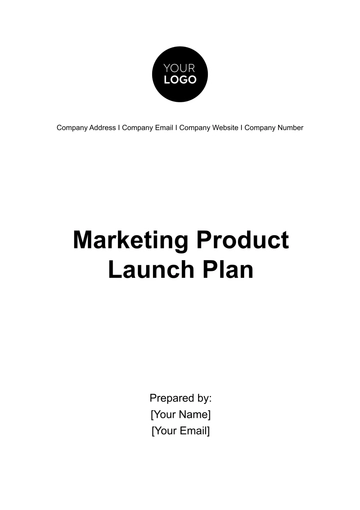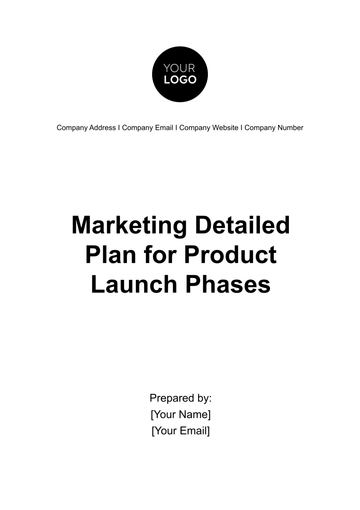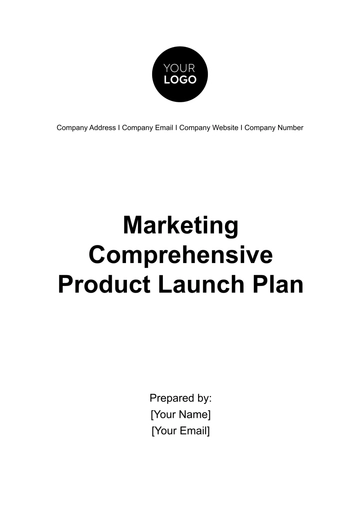Free Marketing Detailed Plan for Product Launch Phases
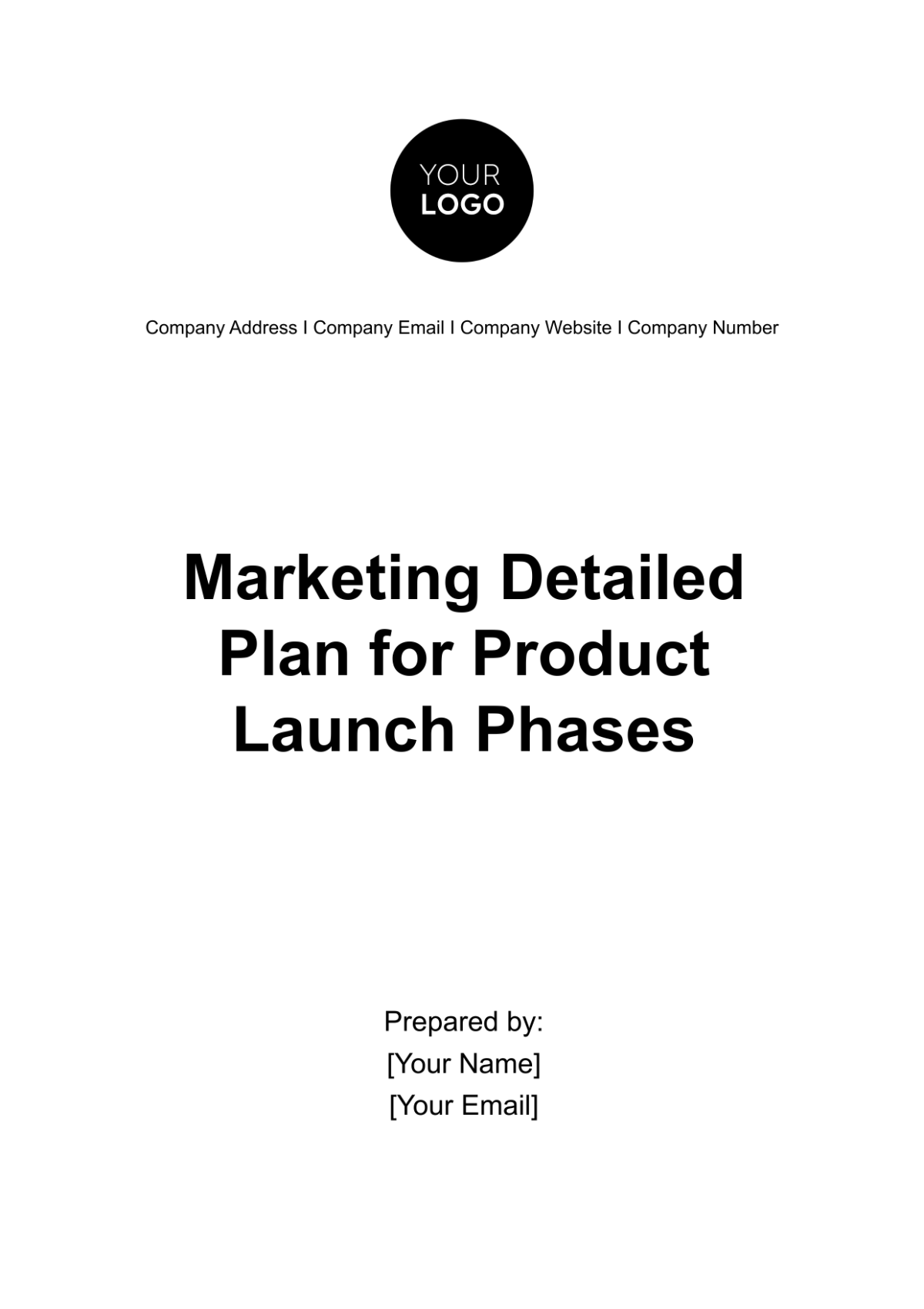
Launch Phases
1. Introduction
1.1 Background
The upcoming product launch represents a significant milestone for [Your Company Name]. We have been diligently developing "TechSolutions Pro," a groundbreaking solution that addresses the growing need for streamlined tech management, over the past two years.
1.2 Objectives
The primary objectives of this product launch plan are as follows:
Create Awareness: Generate widespread awareness about "TechSolutions Pro" within our target audience and industry.
Drive Engagement: Engage our audience through various marketing channels to build anticipation and curiosity leading up to the launch.
Achieve Conversion: Convert the interest and anticipation into sign-ups, inquiries, and ultimately, product sales.
Sustain Growth: After the launch, maintain momentum through ongoing marketing efforts and customer engagement to ensure long-term product success.
2. Pre-launch Phase
Objective: Create anticipation and buzz around the upcoming product launch.
Timeline: April 15, 2050 - May 15, 2050
Key Activities
Market Research and Analysis
As part of our pre-launch strategy, thorough market research will be conducted to identify market trends, potential competitors, and customer preferences. We aim to gather insights that will inform our product positioning and marketing strategies.
Define Target Audience
Our primary target audience consists of tech-savvy professionals in the age range of 25-45, working in medium to large enterprises. Secondary audiences include small business owners and tech enthusiasts.
Develop Product Messaging and Positioning
To differentiate our product in the market, we will highlight its unique features, emphasizing ease of use, scalability, and cost-effectiveness. Our messaging will focus on solving specific pain points of our target audience.
Create Teaser Campaign
A teaser campaign will be launched on our website and social media platforms one month before the official product launch. It will comprise teaser videos, sneak peek images, and interactive quizzes to engage our audience.
Build Landing Page for Email Signups
To capture leads and build excitement, we will create a dedicated landing page on our website where visitors can sign up to receive exclusive updates and early access to the product.
Identify Key Influencers and Partnerships
We will collaborate with industry influencers and potential partners who align with our product's values and can help extend our reach and credibility.
Create Pre-launch Content
High-quality blog posts, social media teasers, and email newsletters will be crafted to build anticipation. Content will include 'Behind-the-Scenes' articles, customer testimonials, and expert interviews.
Set up Email Marketing Automation
An automated email sequence will nurture leads and keep them engaged throughout the pre-launch phase. This will include personalized product sneak peeks and countdown emails.
3. Launch Phase
Objective: Officially introduce and promote the product to the market.
Timeline: May 30, 2050 - June 30, 2050
Key Activities
Product Announcement
On May 30, 2050, we will unveil our product through a live-streamed virtual event. This event will be announced via press releases, social media, and email invitations to our subscriber list.
Launch Event (if applicable)
A launch event will be held at a prestigious venue in New York City for select guests and media. The event will showcase product demonstrations, expert panels, and networking opportunities.
Full-scale Marketing Campaign
A comprehensive marketing campaign will commence on launch day, including social media posts, email blasts, blog articles, and paid advertising on platforms such as Google Ads and LinkedIn Ads.
Monitor and Respond to Customer Feedback
We will closely monitor customer feedback on social media, forums, and our website. A dedicated team will promptly respond to inquiries, suggestions, and concerns.
Collect User-generated Content and Testimonials
Encouraging customers to share their experiences with our product will be a priority. We will request and showcase user-generated content, testimonials, and case studies.
Coordinate with Influencers and Partners
Our pre-established relationships with influencers and partners will be leveraged during the launch phase to amplify our message and reach a wider audience.
Sales Team Training and Support
Our sales team will undergo rigorous product training to ensure they are well-equipped to answer customer queries and effectively promote the product.
4. Post-launch Phase
Objective: Sustain and grow product adoption and maintain customer engagement.
Timeline: July 1, 2050 - August 31, 2050
Key Activities
Continue Marketing Campaigns
To maintain product visibility and engagement, we will continue running marketing campaigns that highlight the benefits and features of "TechSolutions Pro." This includes regular social media updates, blog posts, and email newsletters to our subscriber list.
Analyze Customer Feedback and Iterate
Feedback from our initial users will be carefully analyzed to identify areas for improvement. We will prioritize feature requests and enhancements based on customer input and market demand, ensuring a user-centric approach to product development.
Collect and Share Success Stories
We will actively encourage satisfied customers to share their success stories and experiences with "TechSolutions Pro." These success stories will be featured on our website, in case studies, and across our social media channels.
Plan for Future Product Updates
A product roadmap will be developed to outline future updates and improvements to "TechSolutions Pro." This roadmap will be communicated to our customers, providing transparency and ensuring they are informed about the product's evolution.
Customer Support and Issue Resolution
Our customer support team will be readily available to address user inquiries and resolve any issues promptly. We will prioritize exceptional customer service to build trust and loyalty.
Evaluate and Adjust Marketing Strategies
Our marketing strategies will be continuously evaluated for their effectiveness. Adjustments will be made based on performance data and market trends to ensure our marketing efforts align with our objectives.
5. Ongoing Marketing
Objective: Ensure long-term success and product growth.
Timeline: Ongoing
Key Activities
Content Marketing
Content creation will remain a central component of our marketing efforts. We will regularly produce and share informative blog posts, videos, webinars, and whitepapers that address industry challenges and demonstrate how "TechSolutions Pro" provides solutions.
Email Marketing
Our email marketing campaigns will continue to engage our subscribers with valuable content, product updates, and promotions. We will segment our email lists to deliver personalized messages that resonate with different customer segments.
Social Media Management
Social media platforms will be actively managed to maintain a strong online presence. We will monitor industry conversations, engage with our audience, and share relevant industry news and insights.
Paid Advertising
Paid advertising campaigns will be ongoing, targeting specific keywords and demographics to reach potential customers. We will allocate budgets strategically across platforms such as Google Ads and LinkedIn Ads.
SEO and SEM
Search engine optimization (SEO) and search engine marketing (SEM) will be continuously optimized to improve our organic and paid search rankings. This will include regular keyword research and content optimization.
Customer Relationship Management
Our CRM system will be used to track customer interactions, manage leads, and nurture customer relationships. We will implement strategies to upsell and cross-sell additional products and services to existing customers.
Market Research and Competitor Analysis
Continuous market research will be conducted to stay updated on industry trends and competitor activities. This information will inform our marketing strategies and help us stay ahead of the competition.
6. Key Performance Indicators (KPIs)
In this section, we will outline the key performance indicators (KPIs) that we will be tracking during each phase of our product launch. These KPIs will help us assess the success of our marketing efforts and make data-driven decisions for continuous improvement.
6.1 Pre-launch Phase KPIs
KPI | Measurement | Target |
Website Traffic | Unique visitors | 10,000/month |
Email Signups | Conversion rate | 15% |
Social Media Reach | Follower growth rate | 20% |
Influencer Engagement | Number of mentions | 50 |
Content Engagement | Average time on page | 2 minutes |
6.2 Launch Phase KPIs
KPI | Measurement | Target |
Product Sales | Number of units sold | 1,000 units |
Conversion Rate | Website to purchase | 5% |
Event Engagement | Attendance and feedback | 80% satisfaction |
User-generated Content | Number of submissions | 30 testimonials |
Advertising ROI | Return on ad spend | 300% |
6.3 Post-launch Phase KPIs
KPI | Measurement | Target |
Customer Retention | Churn rate | <5% |
Content Engagement | Social shares and likes | 500 shares |
Customer Feedback | Positive ratings | 90% positive |
SEO Ranking | Keyword rankings | Top 3 for key terms |
Sales Growth | Month-over-month growth | 10% increase |
7. Budget
7.1 Pre-launch Phase Budget
Category | Expense Details | Budget Amount |
Marketing Materials | Teaser video production, design | $10,000 |
Influencer Fees | Payments to influencers and partners | $15,000 |
Content Creation | Blog posts, social media content | $7,000 |
Email Marketing | Software and automation tools | $3,000 |
Landing Page | Development and hosting | $5,000 |
Miscellaneous | Unforeseen expenses | $2,000 |
Total | $42,000 |
7.2 Launch Phase Budget
Category | Expense Details | Budget Amount |
Launch Event | Venue rental, catering, logistics | $25,000 |
Advertising | Paid ads on Google, LinkedIn, etc. | $20,000 |
Content Production | Video production, content creation | $12,000 |
Event Promotion | Print materials, promotional items | $5,000 |
Sales Team Training | Workshops and materials | $8,000 |
Miscellaneous | Unforeseen expenses | $5,000 |
Total | $75,000 |
7.3 Post-launch Phase Budget
Category | Expense Details | Budget Amount |
Ongoing Marketing | Content creation, email marketing | $10,000/month |
Customer Support | Additional support staff and training | $7,000/month |
SEO and SEM | Optimization efforts and ad spend | $15,000/month |
Customer Engagement | Surveys, feedback analysis | $3,000/month |
Market Research | Competitor analysis, research tools | $2,000/month |
Miscellaneous | Unforeseen expenses | $2,000/month |
Total | $39,000/month |
8. Responsibilities
8.1 Pre-launch Phase Responsibilities
John Doe: Market Research and Analysis, Develop Product Messaging and Positioning, Set up Email Marketing Automation
Jane Smith: Define Target Audience, Create Teaser Campaign, Identify Key Influencers and Partnerships
Emma Johnson: Build Landing Page for Email Signups, Create Pre-launch Content
Mark Davis: Social Media Teasers, Content Marketing, Email Marketing Campaigns
Samuel Wilson: Teaser Video Production, Influencer Engagement
8.2 Launch Phase Responsibilities
John Doe: Product Announcement, Full-scale Marketing Campaign, Monitor and Respond to Customer Feedback
Jane Smith: Launch Event Coordination, Sales Team Training and Support
Emma Johnson: Collect User-generated Content and Testimonials, Coordinate with Influencers and Partners
Mark Davis: Social Media Management, Paid Advertising Campaigns
Samuel Wilson: Event Promotion, Event Feedback Analysis
8.3 Post-launch Phase Responsibilities
John Doe: Continue Marketing Campaigns, Customer Support and Issue Resolution, Evaluate and Adjust Marketing Strategies
Jane Smith: Analyze Customer Feedback and Iterate, Collect and Share Success Stories
Emma Johnson: Plan for Future Product Updates, Content Marketing, SEO and SEM
Mark Davis: Social Media Management, Email Marketing
Samuel Wilson: Customer Relationship Management, Market Research and Competitor Analysis
9. Timeline
9.1 Pre-launch Phase Timeline
Market Research and Analysis: March 1, 2050 - March 15, 2050
Define Target Audience: March 16, 2050 - March 30, 2050
Develop Product Messaging and Positioning: March 31, 2050 - April 10, 2050
Create Teaser Campaign: April 11, 2050 - April 30, 2050
Build Landing Page for Email Signups: May 1, 2050 - May 15, 2050
Identify Key Influencers and Partnerships: May 16, 2050 - May 31, 2050
Create Pre-launch Content: June 1, 2050 - June 15, 2050
Set up Email Marketing Automation: June 16, 2050 - June 30, 2050
9.2 Launch Phase Timeline
Product Announcement: July 1, 2050
Launch Event (if applicable): July 5, 2050
Full-scale Marketing Campaign: July 6, 2050 - July 20, 2050
Monitor and Respond to Customer Feedback: July 21, 2050 - July 31, 2050
Collect User-generated Content and Testimonials: August 1, 2050 - August 15, 2050
Coordinate with Influencers and Partners: August 16, 2050 - August 30, 2050
Sales Team Training and Support: September 1, 2050 - September 15, 2050
9.3 Post-launch Phase Timeline
Continue Marketing Campaigns: From September 16, 2050 onwards (Ongoing)
Analyze Customer Feedback and Iterate: From September 16, 2050 onwards (Ongoing)
Collect and Share Success Stories: From September 16, 2050 onwards (Ongoing)
Plan for Future Product Updates: From September 16, 2050 onwards (Ongoing)
Customer Support and Issue Resolution: From September 16, 2050 onwards (Ongoing)
Evaluate and Adjust Marketing Strategies: From September 16, 2050 onwards (Ongoing)
10. Risk Assessment
10.1 Potential Risks and Mitigation Strategies
Technical Issues: Risk of technical glitches or product bugs during the launch phase.
Mitigation: Rigorous testing and quality assurance procedures will be implemented. A contingency plan for quick bug fixes will be in place.
Competitive Pressure: Intense competition from established players in the industry.
Mitigation: Continuous market research and a strong unique selling proposition (USP) will be used to differentiate our product.
Market Shifts: Sudden changes in market trends or customer preferences.
Mitigation: Regular market monitoring and the flexibility to adapt our marketing strategies and product features accordingly.
Budget Constraints: Overrunning the budget for marketing and promotional activities.
Mitigation: A dedicated finance team will monitor expenses closely, and contingency funds will be allocated for unexpected costs.
Negative Publicity: Potential negative reviews or backlash on social media.
Mitigation: A crisis management plan will be in place, including a designated team to respond to and address negative publicity swiftly.
Staffing Challenges: Key team members falling ill or leaving the company unexpectedly.
Mitigation: Cross-training and redundancy in roles to ensure critical tasks can be handled by multiple team members.
11. Conclusion
In conclusion, our product launch plan for "TechSolutions Pro" outlines a comprehensive strategy to create anticipation, execute a successful launch, and sustain long-term growth. We are dedicated to achieving our objectives, from generating awareness and engagement to driving conversions and maintaining customer satisfaction.
This plan emphasizes the importance of data-driven decision-making, continuous improvement, and adaptability in a dynamic market landscape. We are committed to delivering a product that meets the needs of our target audience and establishing [Your Company Name] as a leader in the tech solutions industry.
With the support of our dedicated team and the strategies outlined in this plan, we are confident in the success of the "TechSolutions Pro" product launch and its continued growth in the market.
- 100% Customizable, free editor
- Access 1 Million+ Templates, photo’s & graphics
- Download or share as a template
- Click and replace photos, graphics, text, backgrounds
- Resize, crop, AI write & more
- Access advanced editor
Discover the ultimate game-changer for your product launch strategy with Template.net's Marketing Detailed Plan for Product Launch Phases Template. Crafted for success, this editable and customizable tool empowers you to streamline your launch phases effortlessly. Unlock limitless potential with our Ai Editor Tool, ensuring precision and efficiency every step of the way.
You may also like
- Finance Plan
- Construction Plan
- Sales Plan
- Development Plan
- Career Plan
- Budget Plan
- HR Plan
- Education Plan
- Transition Plan
- Work Plan
- Training Plan
- Communication Plan
- Operation Plan
- Health And Safety Plan
- Strategy Plan
- Professional Development Plan
- Advertising Plan
- Risk Management Plan
- Restaurant Plan
- School Plan
- Nursing Home Patient Care Plan
- Nursing Care Plan
- Plan Event
- Startup Plan
- Social Media Plan
- Staffing Plan
- Annual Plan
- Content Plan
- Payment Plan
- Implementation Plan
- Hotel Plan
- Workout Plan
- Accounting Plan
- Campaign Plan
- Essay Plan
- 30 60 90 Day Plan
- Research Plan
- Recruitment Plan
- 90 Day Plan
- Quarterly Plan
- Emergency Plan
- 5 Year Plan
- Gym Plan
- Personal Plan
- IT and Software Plan
- Treatment Plan
- Real Estate Plan
- Law Firm Plan
- Healthcare Plan
- Improvement Plan
- Media Plan
- 5 Year Business Plan
- Learning Plan
- Marketing Campaign Plan
- Travel Agency Plan
- Cleaning Services Plan
- Interior Design Plan
- Performance Plan
- PR Plan
- Birth Plan
- Life Plan
- SEO Plan
- Disaster Recovery Plan
- Continuity Plan
- Launch Plan
- Legal Plan
- Behavior Plan
- Performance Improvement Plan
- Salon Plan
- Security Plan
- Security Management Plan
- Employee Development Plan
- Quality Plan
- Service Improvement Plan
- Growth Plan
- Incident Response Plan
- Basketball Plan
- Emergency Action Plan
- Product Launch Plan
- Spa Plan
- Employee Training Plan
- Data Analysis Plan
- Employee Action Plan
- Territory Plan
- Audit Plan
- Classroom Plan
- Activity Plan
- Parenting Plan
- Care Plan
- Project Execution Plan
- Exercise Plan
- Internship Plan
- Software Development Plan
- Continuous Improvement Plan
- Leave Plan
- 90 Day Sales Plan
- Advertising Agency Plan
- Employee Transition Plan
- Smart Action Plan
- Workplace Safety Plan
- Behavior Change Plan
- Contingency Plan
- Continuity of Operations Plan
- Health Plan
- Quality Control Plan
- Self Plan
- Sports Development Plan
- Change Management Plan
- Ecommerce Plan
- Personal Financial Plan
- Process Improvement Plan
- 30-60-90 Day Sales Plan
- Crisis Management Plan
- Engagement Plan
- Execution Plan
- Pandemic Plan
- Quality Assurance Plan
- Service Continuity Plan
- Agile Project Plan
- Fundraising Plan
- Job Transition Plan
- Asset Maintenance Plan
- Maintenance Plan
- Software Test Plan
- Staff Training and Development Plan
- 3 Year Plan
- Brand Activation Plan
- Release Plan
- Resource Plan
- Risk Mitigation Plan
- Teacher Plan
- 30 60 90 Day Plan for New Manager
- Food Safety Plan
- Food Truck Plan
- Hiring Plan
- Quality Management Plan
- Wellness Plan
- Behavior Intervention Plan
- Bonus Plan
- Investment Plan
- Maternity Leave Plan
- Pandemic Response Plan
- Succession Planning
- Coaching Plan
- Configuration Management Plan
- Remote Work Plan
- Self Care Plan
- Teaching Plan
- 100-Day Plan
- HACCP Plan
- Student Plan
- Sustainability Plan
- 30 60 90 Day Plan for Interview
- Access Plan
- Site Specific Safety Plan
